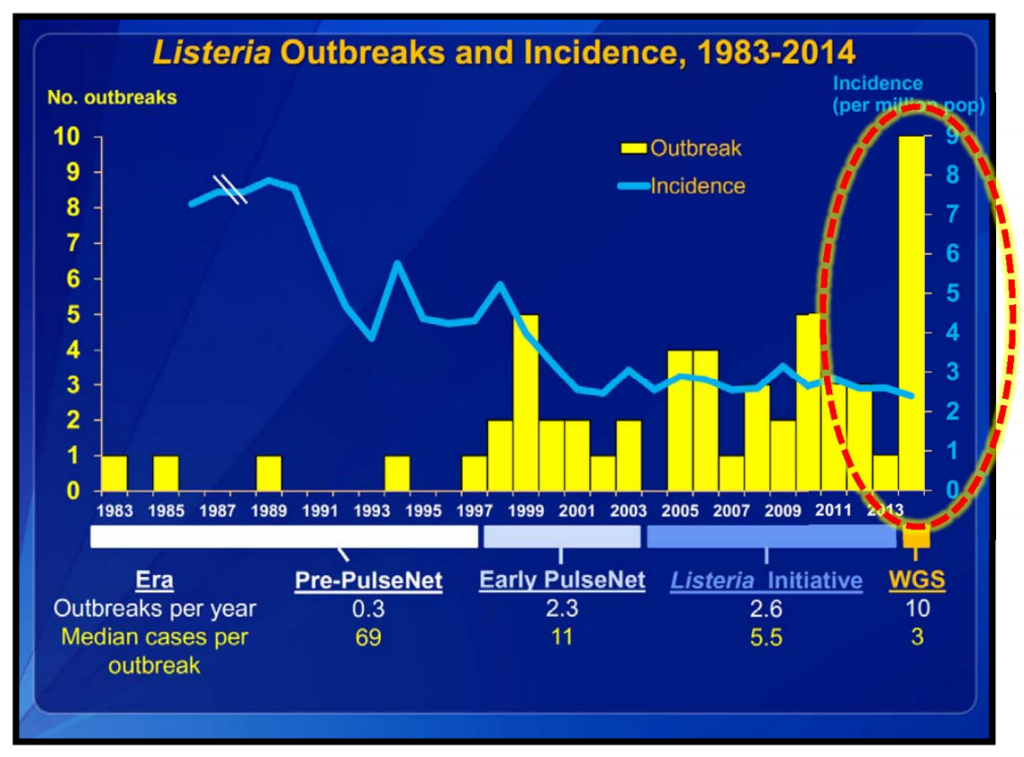Whole genome sequencing, WGS, is a new motivator for enhanced high-touch surface cleaning and handwashing in all locations where people are preparing or serving food. More broadly, it is a robust laboratory procedure for the DNA fingerprinting of pathogens. This advancement provides the opportunity to stop outbreaks sooner and avoid additional illnesses by the rapid and accurate identification of the specific strain of a pathogen while lighting the path to its source.

The CDC, Centers for Disease Control and Prevention, uses this analogy to better appreciate the dimension of this scientific breakthrough: “Instead of only having the ability to compare bacterial genomes using 15-30 bands that appear in a PFGE pattern, we now have millions of bases to compare. That is like comparing all of the words in a book (WGS), instead of just the number of chapters (PFGE), to see if the books are the same or different.”
CDC’s 83 geographically spread PulseNet laboratories, aligned within seven regions, are now using WGS as they scan their respective territories for outbreaks. This advance gives public health officials the ability to solve outbreaks faster and with more accuracy. It is already helping find and define more outbreaks as it reveals the pathways of the stealthier foodborne pathogens.
This new deep-dive into the universe of health-harming organisms carries with it increased risks for the foodservice operator as a new, previously unknown, layer of evidence is penetrated and exposed.
The quick and accurate identification will also help plaintiffs in their pursuit of legal resolution. Speed alone helps but courtroom history shows that a direct connection between the infected person and its source, along with a precise naming of the organism, improves the plaintiff’s award levels.
Look-more find-more outbreak scanning technology
Outbreak is an important word to define for both food producers/food service operators and regulators. A foodborne disease outbreak (FBDO) is classified by the CDC as “an incident in which two or more persons experience a similar illness resulting from the ingestion of a common food.” Might this new WGS tool of accuracy open the door to recognizing and reporting of single incidents of foodborne illness (FBDI)?
Whole genome sequencing is already improving food safety but it clearly puts new pressure on the operator’s food safety control system.
The now unreported causes of FBDOs will increasingly move to the reported column and provide a basis for potential legal action by the plaintiff. CDC statistics show that majority of hospitalizations and deaths — 71,878 and 1,686, respectively — are caused by “unspecified agents” some of which will now likely be identified by WGS. The strength of the WGS technology will only strengthen traditional epidemiology investigations.
Dinner is served.Unresolved outbreaks and even random illness clusters are never closed, but rather filed as “cold cases.” Whole genome sequencing can be used to reopen these cases as the combination of PulseNet’s database and the new GenomeTrakr sequence database builds.
Hand washing for many food producers and food service operators is either not a process at all or one that is completely out of control. It has no standards, no measurement and no data to alert the Person-In-Charge (PIC) when trend lines slip below the agreed standard. Indicators of danger, never reach the C-Suite executives for their input into sustainable corrective actions.
Hand-washing performance remains at the core of the CDC’s recommended interventions: “Hand-washing is the single-most-important means of preventing the spread of infection.”
Original article on Food Safety News, reposted by permission.
Editor’s note: This is the first in a series of three guest opinion columns by Jim Mann in recognition of September as Food Safety Month.
© Food Safety News


